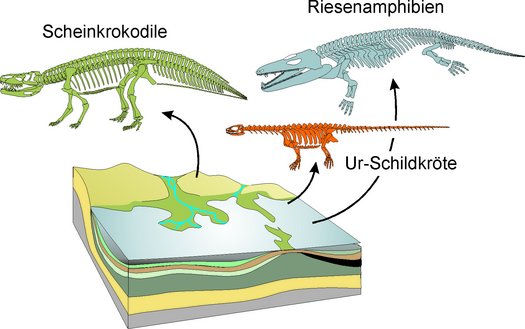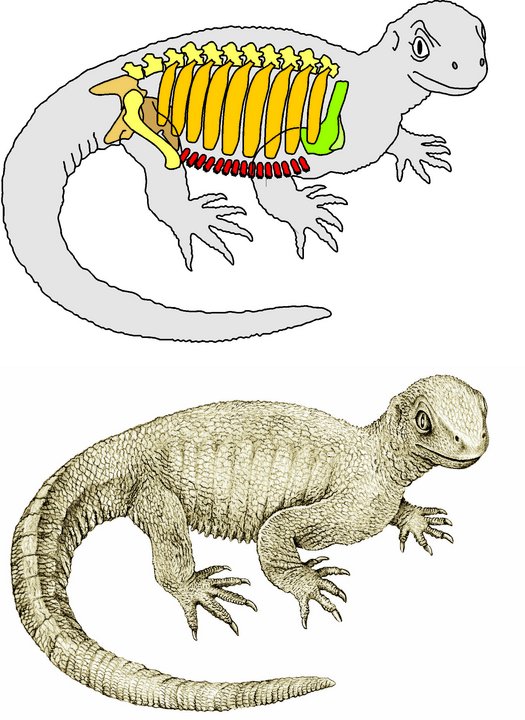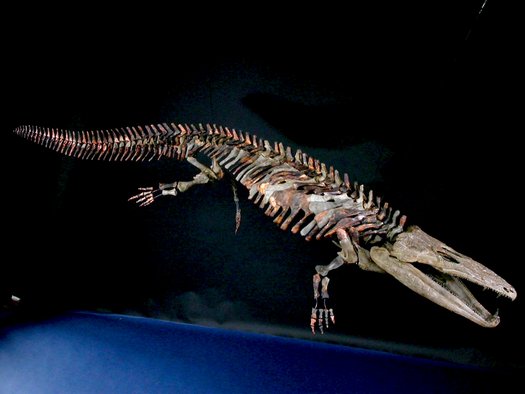Research Interests
Early land vertebrates
We study the evolution of early land vertebrates or tetrapods. To this end, we analyze fossils of the oldest tetrapods, the microstructure of their bones, and the deposits (Fossillagerstätten) in which they are found.
- What were the steps in which evolution progressed when bony fishes started to conquer the land 365 million years ago?
- How diverse were the life cycles of the early tetrapods, and how did the diversity of modern amphibian and amniote ontogenies originate?
- How did the larval stage in modern amphibians evolve, and how widespread was metamorphosis?
- How did organ systems change during the fish-to-tetrapod transition (feeding, respiration, locomotion)?
- Wie wandelten sich die Organe und ihre Funktionen im Zuge des Landgangs (Nahrungsaufnahme, Atmung, Fortbewegung)
- Which life histories (evolutionary strategies) can be reconstructed in the different extinct groups?
Triassic reptiles - a diverse Triassic Park
Our excavations at Fossillagerstätten in southern Germany and beyond have yielded a plethora of data on new tetrapods, especially reptiles. These shed light on the evolution and diversification the the various groups, and also provide evidence for the origin of some long-existing lineages such as turtles or tuataras.
- Early amphibian relatives (temnospondyls) Trematolestes hagdorni, Kupferzellia wildi, Callistomordax kugleri, Megalophthalma ockerti
- Amniote relatives (chroniosuchians) Bystrowiella schumanni
- Early lizard relatives (lepidosaurs): Fraxinisaura rozynekae, Vellbergia bartholomaei
- Enigmatic reptiles: Quasicolognathus eothen, Stauromatodon mohli
- Early relatives of crocodiles and birds (Archosauromorpha): Rutiotomodon tytthos, Polymorphodon adorfi, Jaxtasuchus salomoni
- Crocodile-line taxa (Pseudosuchia): Batrachotomus kupferzellensis, Apatosuchus orbitoangulatus
- The most ancient tuatara (rhynchocephalian) Wirtembergia hauboldae
- The most ancient relative of turtles (stem-turtle Pappochelys rosinae)
Triassic ecosystems
The analysis of numerous excavation data and geological observations enable us to reconstruct the environments in which the Triassic tetrapods existed. We are particularly interested in the trophic relations (food webs) and their change across the Permo-Triassic boundary. The Triassic was a key period for the evolution of many modern tetrapod groups, and our studies combine this topic with manifold new data on past climate change as a driver of evolutionary diversification.
- What was the impact of the catastrophic hothouse climate of the early Triassic on land vertebrates?
- Which survival strategies did tetrapods evolve to cope with the extreme conditions?
- How did the ecosystems in rivers and lakes respond to the harsh conditions, and in how did they recover?
Methods
- Anatomy of the skeleton
- Histology and microstructure of bones
- CT-Scans
- Geochemistry (cooperation with the University of Mainz)



